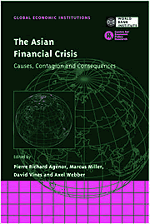Book contents
- Frontmatter
- Contents
- List of figures
- List of tables
- Preface
- List of conference participants
- Acknowledgements
- List of abbreviations and acronyms
- Introduction
- Part One General Accounts
- 1 The role of macroeconomic and financial sector linkages in East Asia's financial crisis
- Discussion
- 2 The Asian crisis: lessons from the collapse of financial systems, exchange rates and macroeconomic policy
- Discussion
- 3 Are capital inflows to developing countries a vote for or against economic policy reforms?
- Discussion
- 4 The Asian crisis: an overview of the empirical evidence and policy debate
- Discussion
- Part Two Theoretical Contributions
- Part Three Contagion
- Part Four Policy Responses
- Index
3 - Are capital inflows to developing countries a vote for or against economic policy reforms?
from Part One - General Accounts
Published online by Cambridge University Press: 26 February 2010
- Frontmatter
- Contents
- List of figures
- List of tables
- Preface
- List of conference participants
- Acknowledgements
- List of abbreviations and acronyms
- Introduction
- Part One General Accounts
- 1 The role of macroeconomic and financial sector linkages in East Asia's financial crisis
- Discussion
- 2 The Asian crisis: lessons from the collapse of financial systems, exchange rates and macroeconomic policy
- Discussion
- 3 Are capital inflows to developing countries a vote for or against economic policy reforms?
- Discussion
- 4 The Asian crisis: an overview of the empirical evidence and policy debate
- Discussion
- Part Two Theoretical Contributions
- Part Three Contagion
- Part Four Policy Responses
- Index
Summary
In the summer of 1993 the World Bank Economic Development Institute asked me to prepare a paper for a conference evaluating the remarkable capital inflows that were then seen as both a problem and a blessing for developing countries in Latin America and Asia. The audience comprised senior officials from central banks and finance ministries in the emerging market countries. A revised version of that presentation is the foundation for this chapter. The argument presented is that capital inflows to emerging markets were motivated by a three-part government insurance policies.
The three ingredients were fixed exchange rates, lender-of-last-resort (LOLR) commitments and open capital markets. The paper warned that one of the three links in the insurance chain would have to be broken: if not broken voluntarily, the market would eventually force a regime change. With the benefit of hindsight it appears that these warnings were closer to the mark than the author, much less the audience, imagined. The key analytic point raised by the paper is that a sequence of capital inflows followed by sudden reversals is entirely consistent with rational investor behaviour. So-called ‘convergence play’ inflows to European countries before the crises in 1992, and deposit inflows into US Savings and Loans (S&Ls) before the crisis, are cited as examples of episodes in which investors moved into a country, or financial intermediary, with every intention of moving out under the umbrella of free government insurance. Moreover, the build-up of implicit government liabilities would eventually generate a successful speculative attack that would end the regime. These issues remain at the heart of arguments over reform of the international monetary system examined in this volume.
- Type
- Chapter
- Information
- The Asian Financial CrisisCauses, Contagion and Consequences, pp. 112 - 123Publisher: Cambridge University PressPrint publication year: 1999
- 5
- Cited by



